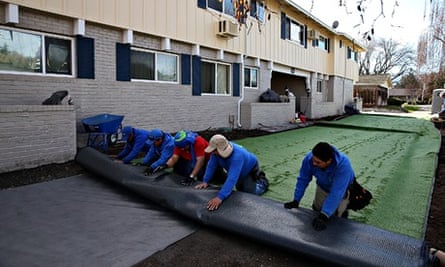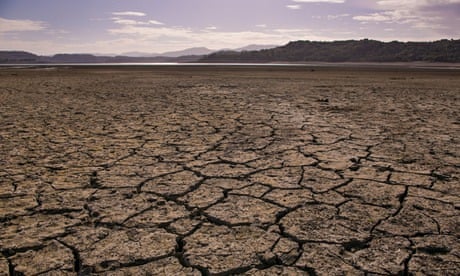Communities across California are begging – and in some cases ordering – people to save water as the region experiences a historic drought. But it's not easy to get people to turn off the taps, especially when so many Californians have no idea how much water they are using.
About 225,000 homes and businesses across the state still do not charge customers for the water they are using, according to an analysis by the San Jose Mercury News.
Those communities use 39% more water per capita than the state average – and local authorities have little recourse when it comes to cracking down on overuse.
Some towns are sending out patrols to check for surreptitious lawn watering. Some towns say motorists can only wash their cars with buckets. Other towns are poring over water records to spot spikes in use. Still others are resorting to turning off the mains if homeowners do not fix leaks on time.
But said Cloverdale city manager, Paul Cayler: "It's tough. The people who are conserving water were already conserving water."

The San Francisco Bay area town of about 10,000 was one of the first to ration water in the drought, ordering a mandatory 25% water cut after state authorities warned it could run out of water in 100 days.
Cayler said the town was on course to pare its use by 30%.
But it has been a full-on effort. The town is sending out patrol cars to search for people filling swimming pools or using a sprinkler to water their lawns, activities banned under the restrictions.
"We are finding them by driving around neighbourhoods and seeing people irrigating with sprinklers and over-spraying," Cayler said.
The biggest water savings was at the local fire station, where patrols discovered a leak.
The town ordered the cuts after state authorities said Cloverdale was in danger of running out of water in the coming weeks.

In addition to the hosepipe ban, restaurants in the town were told not to serve water to diners, unless asked.
Other towns on the frontline of the drought – mainly small and remote communities – were struggling to cut back.
In Lompico Canyon, a tiny community north of Santa Cruz – which is also rationing water – the water system runs to fewer than 500 homes.
Residents were struggling to meet a mandatory 30% cut in water use, said Lois Henry, who heads the local water board.
Even before the drought, residents here were used to saving water.
Homes here are nestled in redwoods and other trees. They don't have lawns – the biggest draw on residential water use, Henry said. "People don't have lawns. They don't have gardens. How are they going to conserve 30%."
One of her customers uses only four units of water, just over 1,000 US gallons, every two months. "How is she going to cut that?"
Henry said she bought a new washing machine and dryer – even though her old ones still worked well – to try and save on water. The newer models uses about a third of the water of her old machines.
Other residents have resorted to washing their hands in finger bowls, instead of a running tap. When rain last month offered a brief respite from the drought, they put out buckets.
But it's far from clear how much water such measures will save.
About 80% of water goes for agriculture. In terms of business and residential use, Californians get their water from about 3,000 different providers across the state - each with a different set of rules.
The governor, Jerry Brown, in declaring the drought emergency in January, urged Californians to voluntarily cut their water use by 20% and most towns have stuck with voluntary restrictions.
Some water districts – like tiny Lompico Canyon – rely on just three wells a creek, which is currently too low to drawn on.
Other water districts serve millions, such as the metropolitan water district, that serves 19 million people in the Los Angeles and San Diego areas.
Many of those users have no idea how much water they are using because they don't have water meters.
The San Jose Mercury news found 225,000 homes and businesses still did not have water meters, and that customers were charged a flat rate for water use.
About half of the homes in Sacramento alone still don't have water meters, which means the city has no way of limiting use or penalising those who fail to cut back.
Meanwhile, a recent study found Americans under-estimate their water use by a factor of two. In addition, they had little clear idea of what they could do to help conserve water in the home.
So far, most of the bigger towns and cities are trusting Californians to follow governor Jerry Brown's call and voluntarily cut their water use.
Those few that have imposed mandatory rationing – such as Cloverdale and Lompico Canyon – are counting on locals to do their bit.
Others, such as St Helena, have threatened fines of up to $1,000 for those who repeatedly go over the ration of 65 US gallons a day.
Henry said Lompico Canyon was not quite ready to take that step. But she said: "If it's just wilful [lack of water conservation] we can shut the water off."

Comments (…)
Sign in or create your Guardian account to join the discussion